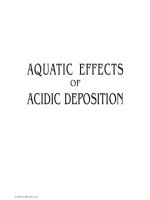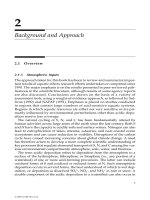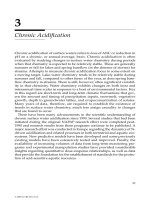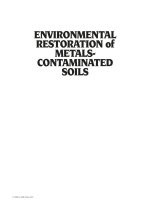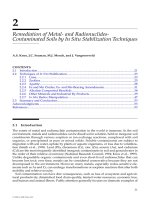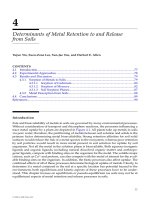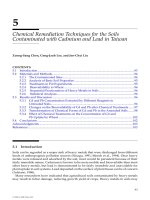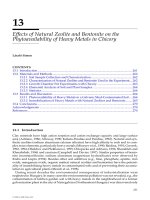Bioremediation of Relcalcitrant Compounds - Chapter 1 potx
Bạn đang xem bản rút gọn của tài liệu. Xem và tải ngay bản đầy đủ của tài liệu tại đây (1.15 MB, 20 trang )
B
ioremediation
of
R
elcalcitrant
C
ompounds
© 2006 by Taylor & Francis Group, LLC
A CRC title, part of the Taylor & Francis imprint, a member of the
Taylor & Francis Group, the academic division of T&F Informa plc.
B
ioremediation
of
R
elcalcitrant
C
ompounds
EDITED BY
JEFFREY W. TALLEY
Boca Raton London New York Singapore
© 2006 by Taylor & Francis Group, LLC
Published in 2006 by
CRC Press
Taylor & Francis Group
6000 Broken Sound Parkway NW, Suite 300
Boca Raton, FL 33487-2742
© 2006 by Taylor & Francis Group, LLC
CRC Press is an imprint of Taylor & Francis Group
No claim to original U.S. Government works
Printed in the United States of America on acid-free paper
10987654321
International Standard Book Number-10: 1-56670-656-4 (Hardcover)
International Standard Book Number-13: 978-1-56670-656-8 (Hardcover)
Library of Congress Card Number 2005043923
This book contains information obtained from authentic and highly regarded sources. Reprinted material is
quoted with permission, and sources are indicated. A wide variety of references are listed. Reasonable efforts
have been made to publish reliable data and information, but the author and the publisher cannot assume
responsibility for the validity of all materials or for the consequences of their use.
No part of this book may be reprinted, reproduced, transmitted, or utilized in any form by any electronic,
mechanical, or other means, now known or hereafter invented, including photocopying, microfilming, and
recording, or in any information storage or retrieval system, without written permission from the publishers.
For permission to photocopy or use material electronically from this work, please access www.copyright.com
( or contact the Copyright Clearance Center, Inc. (CCC) 222 Rosewood Drive,
Danvers, MA 01923, 978-750-8400. CCC is a not-for-profit organization that provides licenses and registration
for a variety of users. For organizations that have been granted a photocopy license by the CCC, a separate
system of payment has been arranged.
Trademark Notice: Product or corporate names may be trademarks or registered trademarks, and are used only
for identification and explanation without intent to infringe.
Library of Congress Cataloging-in-Publication Data
Bioremediation of recalcitrant compounds / edited by Jeffrey Talley.
p. cm.
Includes bibliographical references and index.
ISBN 1-56670-656-4
1. Organic compounds Biodegradation. 2. Organochlorine compounds Biodegradation. 3.
Bioremediation. I. Talley, Jeffrey.
TD196.O73B558 2005
628.5 dc22 2005043923
Visit the Taylor & Francis Web site at
and the CRC Press Web site at
Taylor & Francis Group
is the Academic Division of T&F Informa plc.
L1656_Discl.fm Page 1 Monday, July 11, 2005 10:41 AM
© 2006 by Taylor & Francis Group, LLC
Preface
This book summarizes many of the results of a 7-year research effort con-
ducted by the Federal Integrated Biotreatment Research Consortium
(FIBRC). The purpose of the work presented in this book was to develop
bioremediation technologies for soil, sediment, and groundwater contami-
nated with chlorinated solvents, polychlorinated biphenyls (PCBs), and
polycyclic aromatic hydrocarbons (PAHs). The Strategic Environmental
Research and Development Program (SERDP) sponsored this project under
its cleanup thrust area and assigned it project number CU-720. The U.S.
Army Engineer Research and Development Center (ERDC) directed the
FIBRC research program, which was entitled “Biotreatment: Flask to Field
Initiative.”
Active membership of the FIBRC whose work is represented in this book
consisted of the following organizations:
U.S. ERDC, Environmental Laboratory, Waterways Experiment Station,
Vicksburg, MS
U.S. Army Natick Research, Development and Engineering Center,
Natick, MA
U.S. Army Corps of Engineers (USACE), Baltimore District, Baltimore,
MD
U.S. Naval Research Laboratory, Washington, D.C.
U.S. Naval Command, Control and Ocean Surveillance Center Research,
Development, Test and Evaluation Division (NRaD), San Diego, CA
U.S. Environmental Protection Agency (USEPA), Environmental
Research Laboratory, Athens, GA
USEPA Robert S. Kerr Laboratory, Ada, OK
Great Lakes and Mid-Atlantic Hazardous Substance Research Center
(GLMAC), Ann Arbor, MI
In addition, the following organizations participated in the FIBRC in an
advisory capacity:
ERDC, Cold Regions Research Engineering Laboratory (CRREL),
Hanover, NH
L1656_C000.fm Page v Monday, July 11, 2005 11:25 AM
© 2006 by Taylor & Francis Group, LLC
ERDC, Construction Engineering Research Laboratory (CERL),
Champaign, IL
U.S. Army Environmental Center, Aberdeen Proving Ground, MD
U.S. Department of Energy (DOE), Argonne National Laboratory,
Argonne, IL
I was the FIBRC director for most of the work, although Dr. Mark Zappi,
P.E. (ERDC/Mississippi State University) and Dr. Kurt Preston (ERDC/Army
Research Office) served as the initial directors. Dr. Rakesh Bajpai (University
of Missouri–Columbia) served as an interim director for 1 year. Thank you,
Mark, Kurt, and Rakesh, for providing great leadership. My executive assis-
tant was Ms. Deborah Felt, Applied Research Associates (ARA), whose daily
contributions were invaluable … thanks, Debbie.
To my lead authors, Dr. Jim Tiedje (Michigan State University), Dr. Hap
Prichard (Naval Research Laboratory), and Dr. Guy Sewell (EPA Robert S.
Kerr Research Laboratory/East Central University), your long hours of work
are greatly appreciated. Equally important is the list of other coauthors and
contributors. My thanks to all of you.
Thank you, SERDP, for funding this work and giving us great folks to
work with, such as Ms. Cathy Vogel (SERDP’s program manager for the
cleanup thrust area), Dr. Femi Ayorinde (program manager), and Mr. Bradley
Smith and Dr. John Harrison (SERDP directors). Special thanks to ERDC and
Daniel E. Averett for their support of this project.
Thank you, Technical Advisory Committee (all great scholars and too
many to mention here) and Mr. Richard Conway (SERDP project shepherd),
for keeping us focused to produce this work.
Thank you, Dr. Xiangru Zhang (University of Notre Dame) and Mr. Tim
Ruggaber (University of Notre Dame) for your valuable assistance in proof-
reading this manuscript!
Finally, thank you to all the staff at CRC Press and Taylor & Francis.
Without your prodding, this book would never have been completed.
Jeffrey W. Talley
Notre Dame, Indiana
L1656_C000.fm Page vi Monday, July 11, 2005 11:25 AM
© 2006 by Taylor & Francis Group, LLC
The Editor
Dr. Jeffrey W. Talley, P.E.,
is an Assistant Professor of Bioengineering and
Environmental Engineering in the Department of Civil Engineering and
Geological Sciences, University of Notre Dame, Notre Dame, Indiana. He
specializes in the treatment of contaminated surface water, groundwater,
soil, and sediment. His research interests include the examination of phys-
iochemical and microbial processes for application to waste reduction and
treatment. Special interests are phase partitioning and the treatment and fate
of hydrophobic organic compounds (Dioxins, PCBs, PAHs, DDT), other
tightly bound pollutants (TNT, RDX, HMX), and select inorganic contami-
nants (Hg, Pb, Cr, and As) in the environment. He is especially interested in
the integration of engineering, microbial ecology, and toxicology for pur-
poses of enhancing detection, characterization, and remedial strategies. Pro-
fessor Talley teaches Introduction to Environmental Engineering and Sci-
ence, Hazardous Waste Management and Design, and Physiochemical
Processes and Treatment of Pollutants.
Professor Talley is noted for his innovative applications of thermal pro-
grammed desorption mass spectrometry (TPD/MS) for the assessment of
pollutants and his contributions to the development of treatment technolo-
gies with focus on field remediation. His work involving the bioavailability
of PAHs in sediments was part of the team project honored as 1999 SERDP
Research Project of the Year (Cleanup) and best research presented (poster)
at the 2000 Gordon Research Conference on Environmental Science. His
recent collaborative work involving the detection and analyses of toxic heavy
metals and organic acids in herbal dietary supplements was part of a team
project honored as best research presented at the 2004 International Sympo-
sium on Recent Advances in Pharmacology.
Prior to his appointment at Notre Dame, Dr. Talley spent 20 years in
design, consulting, and military positions involving more than 100 different
environmental sites throughout the United States and abroad. In 2003, Pro-
fessor Talley was in the Middle East with the U.S. Army Corps of Engineers
conducting civil and environmental engineering projects throughout Kuwait
and Iraq. Of special significance was his environmental work with Task Force
Restore Iraqi Oil (TF RIO), where he assisted in the assessment and remedi-
ation recommendations for multiple oil-waste impacted sites in Iraq.
L1656_C000.fm Page vii Monday, July 11, 2005 11:25 AM
© 2006 by Taylor & Francis Group, LLC
Contributors
Dr. Michael Annable
Department of Environmental
Engineering and Science
University of Florida–Gainesville
Gainesville, Florida
Dr. Herbert Fredrickson
U.S. Army Engineer Research and
Development Center
Environmental Laboratory at
Waterways Experiment Station
Vicksburg, Mississippi
John S. Furey
U.S. Army Engineer Research and
Development Center
Environmental Laboratory at
Waterways Experiment Station
Vicksburg, Mississippi
Dr. Lance D. Hansen
U.S. Army Engineer Research and
Development Center
Cold Regions Research and
Engineering Laboratory
Hanover, New Hampshire
Dr. John Hind
Maryland Biotechnology Institute
Baltimore, Maryland
Desirée P. Howell
RMT, Inc.
Jackson, Mississippi
Dr. William Jones
Maryland Biotechnology Institute
Baltimore, Maryland
Dr. Joanne Jones-Meehan
Naval Research Laboratory
Washington, D.C.
Susan C. Mravik
USEPA-RSK Lab
Ada, Oklahoma
Cathy Nestler
Applied Research Associates, Inc.,
Southern Division
Vicksburg, Mississippi
Dr. Kurt D. Pennell
School of Civil and Environmental
Engineering
Georgia Institute of Technology
Atlanta, Georgia
Dr. Hap Prichard
Naval Research Laboratory
Washington, D.C.
Dr. Guy Sewell
East Central University
Department of Environmental
Health Sciences
Ada, Oklahoma
L1656_C000.fm Page ix Monday, July 11, 2005 11:25 AM
© 2006 by Taylor & Francis Group, LLC
Dr. Randy Sillan
LFR Levine Fricke
Emeryville, California
William Straube
Geo-Centers, Inc.
Washington, D.C.
Dr. Jeffrey W. Talley, P.E.
Department of Civil Engineering
and Geological Sciences
University of Notre Dame
Notre Dame, Indiana
Dr. James M. Tiedje
Center for Microbial Ecology
Michigan State University
East Lansing, Michigan
Dr. Tamara V. Tsoi
Center for Microbial Ecology
Michigan State University
East Lansing, Michigan
Dr. Altaf Wani
U.S. Army Engineer Research and
Development Center
Vicksburg, Mississippi
Kevin Warner
LFR Levine Fricke
Emeryville, California
Dr. A. Lynn Wood
USEPA-RSK Lab
Ada, Oklahoma
L1656_C000.fm Page x Monday, July 11, 2005 11:25 AM
© 2006 by Taylor & Francis Group, LLC
Introduction
This book provides an authoritative state-of-the-art biotreatment review for
three key contaminant groups: chlorinated solvents, polychlorinated biphe-
nyls (PCBs), and polycyclic aromatic hydrocarbons (PAHs). Issues such as
availability, toxicity, and treatability are discussed along with a summary of
the latest bioremediation technologies. Special innovative research and
development projects are presented for each contaminant group. These
projects are the results of a 7-year concerted effort by the Strategic Environ-
mental Research Development Program’s (SERDP) Federal Integrated
Biotreatment Research Consortium funded by the Department of Defense
(DOD), Department of Energy (DOE), and Environmental Protection Agency
(EPA). The consortium’s objective was to develop field-ready biotechnolo-
gies. The technologies developed through this program yielded successful
field or large-scale lab demonstrations for each contaminant group. Cosol-
vent extraction of chlorinated solvents was validated at a field site, and a
guidance document explaining the technology was developed. Bioaugmen-
tation-enhanced PAH degradation was compared to traditional land-farming
methods and provided new insight on how to optimize biotreatment. Genet-
ically engineered microorganisms (GEMs) that enhanced PCB degradation
were developed and field tested, and a GEM guidance document was writ-
ten. These projects discuss both the science and engineering challenges that
were encountered as each project advanced from the flask to the field. They
serve as useful guides for the implementation of any new bioremediation
technology.
L1656_C000.fm Page xi Monday, July 11, 2005 11:25 AM
© 2006 by Taylor & Francis Group, LLC
Contents
Chapter 1
Introduction to recalcitrant compounds 1
Jeffrey W. Talley
Chapter 2
Toxicological exposure of bound recalcitrant compounds 11
Herbert Fredrickson, John S. Furey, and Jeffrey W. Talley
Chapter 3
Roadblocks to the implementation of biotreatment strategies 33
Jeffrey W. Talley
Chapter 4
The federal integrated biotreatment research consortium
(flask to field) 51
Jeffrey W. Talley
Chapter 5
Chlorinated solvent contaminated soils and groundwater:
field application of the solvent extraction residual
biotreatment technology 59
Guy Sewell, Susan C. Mravik, A. Lynn Wood,
Michael Annable, Randy Sillan, and Kevin Warner
Chapter 6
Enhancing PCB bioremediation 147
James M. Tiedje, Tamara V. Tsoi, Kurt D. Pennell,
Lance D. Hansen, Altaf Wani, and Desirée P. Howell
Chapter 7
Polycyclic aromatic hydrocarbons (PAHs): improved land
treatment with bioaugmentation 215
Hap Prichard, Joanne Jones-Meehan, Cathy Nestler,
Lance D. Hansen, William Straube, William Jones, John Hind, and
Jeffrey W. Talley
L1656_C000.fm Page xiii Monday, July 11, 2005 11:25 AM
© 2006 by Taylor & Francis Group, LLC
Chapter 8
Future needs for research and development 301
Jeffrey W. Talley
L1656_C000.fm Page xiv Monday, July 11, 2005 11:25 AM
© 2006 by Taylor & Francis Group, LLC
1
chapter one
Introduction to recalcitrant
compounds
Jeffrey W. Talley
Contents
1.1 Introduction 1
1.2 Relevance 2
1.3 Biodegradation and bioavailability 3
1.4 The sequestration of recalcitrant compounds 4
References 7
1.1 Introduction
Bioremediation is defined by the U.S. Environmental Protection Agency
(EPA) as a managed or spontaneous process in which microbiological pro-
cesses are used to degrade or transform contaminants to less toxic or nontoxic
forms, thereby remedying or eliminating environmental contamination
(EPA, 1994). These microbiological processes may reduce hydrocarbon con-
centrations in various types of soils and sediments to levels that no longer
pose an unacceptable risk to the environment or human health (Linz and
Nakles, 1997). However, hydrocarbons that remain in treated soils and sed-
iments still might not meet stringent regulatory levels, even if they represent
site-specific, environmentally acceptable endpoints (NRC, 1997). This unre-
solved issue of the availability of residual hydrocarbon contaminants is the
focus of this work.
There is a great need to understand contaminant soil–sediment interac-
tions and their effect on bioavailability and toxicity (NCR, 1997). This is
especially true for recalcitrant compounds. The adherence and slow release
of recalcitrant compounds from soils and sediments is an obstacle to
L1656_C001.fm Page 1 Tuesday, July 5, 2005 3:21 PM
© 2006 by Taylor & Francis Group, LLC
2 Bioremediation of Recalcitrant Compounds
remediation (NCR, 1994; Moore et al., 1989)
and is challenging our concepts
about cleanup standards and risks (Alexander, 1995). This is particularly the
case for biological treatment of recalcitrant compounds, in which one of the
most important site-specific factors is the availability of the compounds held
within solids and how this affects treatment rates and acceptable toxicolog-
ical endpoints.
Biostabilization is a newly developed concept that could significantly
benefit the remediation process for soils and sediments contaminated with
recalcitrant compounds. Biostabilization is the biodegradation of accessible
pollutant fractions in a soil or sediment matrix, leaving a bound residue that
is much more biologically unavailable and immobile (Luthy et al., 1997). The
concept, however, is still in a developmental stage, and endpoints and appro-
priate measures of endpoints have not been defined. Very little research has
been conducted on the applicability of biostabilization principles. It has been
hypothesized that residual hydrocarbons remaining after biotreatment may
represent an acceptable treatment endpoint. This is an important concept,
but for wide acceptance, better understanding of the polycyclic aromatic
hydrocarbon (PAH) release rates and mechanisms that bind or sequester
recalcitrant compounds within contaminated material is required.
1.2 Relevance
Recalcitrant compounds present one of the most pressing problems for
biotreatment of contaminated soils or sediments. These compounds consti-
tute a broad class of chemicals that appear as persistent contaminants in
soils and sediments (NRC, 1997, 1994), including petroleum and fuel resi-
dues, tars, and creosotes. Such compounds have low solubility, low volatility,
low intrinsic reactivity, and they typically exhibit very slow release rates
from soil or sediment (Steinberg et al., 1987; Pignatello and Xing, 1996). These
characteristics make biotreatment difficult in any geologic setting, necessi-
tating extensive, site-specific testing. These characteristics also confound risk
assessment, wherein the availability of recalcitrant compounds to organisms
or the environment is unknown.
In theory, soils and sediments contaminated with recalcitrant com-
pounds may be treated utilizing various cleanup strategies. However, many
proposed strategies have significant economic and feasibility problems.
What is needed is an effective technology that supports the economics of
disposal, eliminates adverse contaminant impacts, and supports the reuse
of treated contaminated soils and sediments. In-place (
in situ
) biotreatment
combined with biostabilization offers a strong possibility to achieve these
goals. Regardless of whether the biotreatment system is passive (natural
attenuation) or engineered (in-place treatment), a pragmatic solution is to
focus active biotreatment on the available contaminant fraction and confirm
that if residuals are released, the rate is sufficiently slow to allow consump-
tion by the microbial community, i.e., the contaminant is biostabilized. Thus,
an alternative environmental endpoint (cleanup level) may be appropriate,
L1656_C001.fm Page 2 Tuesday, July 5, 2005 3:21 PM
© 2006 by Taylor & Francis Group, LLC
Chapter one: Introduction to recalcitrant compounds 3
rather than basing decisions solely on total concentration of contaminant in
the soil or sediment.
It is also necessary to improve assessment of the toxicity and risk from
residual hydrocarbons. Mechanisms that affect release rates and exposure
need to be better defined. The potential benefits of such work could include
reduced treatment costs, improved evaluation and design for cleanup tech-
nologies, greater regulatory and public acceptance of biotechnology,
increases in the reuse/recovery opportunities for treated contaminated sed-
iments, and potential application for
in situ
capping of contaminated soils
and sediments.
1.3 Biodegradation and bioavailability
Recalcitrant compounds in soils and sediments may be biodegraded by
microorganisms to a residual concentration that no longer decreases with
time or that decreases slowly over years with continued treatment (Thoma,
1994; Luthy et al., 1994; Loehr and Webster, 1997). Further reductions are
believed to be limited by the availability of the recalcitrant compounds to
microorganisms (Bosma et al., 1997; Erickson, 1993). Attempts have been
made to increase this availability through the use of surfactants, but results
have varied (Putcha and Domach, 1993; Bury and Miller, 1993; Chung et al.,
1993; Edwards et al., 1994; Auger et al., 1995). Additionally, as contaminants
age, they become less available compared to freshly contaminated material.
As a consequence of binding with soils and sediments and subsequent slow
release rates, residual recalcitrant compounds may be significantly less leach-
able by water and less toxic as measured by uptake tests (Alexander, 1995;
GRI, 1995; Kelsey et al., 1997).
Generally, contaminants can be degraded only when they exist in the
aqueous phase and come into contact with the cell membrane of a microor-
ganism. In this way, the contaminant serves as a substrate for the microor-
ganism and is incorporated through membrane transport into the cell and
utilized as an energy source in the cell’s principal metabolic pathways.
However, physical or chemical phenomena can limit the bulk solution con-
centration of the contaminant and thus significantly reduce the ability of the
microorganisms to assimilate the contaminant. Therefore, the bioavailability
of the contaminant can control the overall biodegradation of these com-
pounds.
Another important factor relevant to biodegradation and bioavailability
is the location and density of microorganisms. The majority of bacteria in
the environment are attached to surfaces, and their distribution in and on
soils/sediments is very patchy. The majority of these bacteria range in size
from 0.5 to 1.0
µ
m, whereas micropores present in soils and sediments
measure far less than 1
µ
m. It is generally believed that bacteria are attached
predominantly to the surfaces of soils and sediments and not to the interior
surfaces of the micropores. It has been estimated that more than 90 of the
microorganism types present in geologic matrices accumulate on the surfaces
L1656_C001.fm Page 3 Tuesday, July 5, 2005 3:21 PM
© 2006 by Taylor & Francis Group, LLC
4 Bioremediation of Recalcitrant Compounds
of soils/sediments (Costerton et al., 1987). Therefore, the majority of con-
taminant–microbial interactions occur in the biofilm that develops within
macropores on the surfaces of soils/sediments.
This suggests that partitioning of an organic contaminant from the solid
phase of the soil/sediment to the aqueous phase in the larger pore spaces
controls soil/sediment bioavailability. These partitioning mechanisms may
include chemical bonding, surface complex formations, electrostatic interac-
tions, and hydrophobic effects (Schwarzenbach et al., 1993; Stumm, 1992).
For hydrophobic contaminants such as recalcitrant compounds, sorption
increases with the content of the organic matter in the soil/sediment and
the degree of hydrophobicity of the specific PAH. Typically, the rate of
desorption can be attributed to the mass transfer of the sorbate molecules
from sorption sites on and in the soil/sediment. Active bacteria should
correspond to the higher available PAH concentrations, which occurs where
desorption is the most intense.
1.4 The sequestration of recalcitrant compounds
As already discussed, the partitioning of recalcitrant compounds represents
a significant part of the mass transfer process. However, describing this
process is complicated by a combination of diffusion, dissolution, encapsu-
lation, and adsorption phenomena. The combined effect of these factors can
generally be defined as sequestration (Luthy et al., 1997). The complexities
of sequestration can best be understood in terms of examining the different
scales of observation associated with the heterogeneity of soils and sedi-
ments. Shown in Figure 1.1 are mineral surfaces in meso- and micropores
(Luthy et al., 1997), both amorphous and condensed natural sorbent organic
matter (SOM), and anthropogenic organic phase matter. The circled letters
refer to different sorption mechanisms associated with specific domains
within soils and sediments:
Case A represents absorption into amorphous or soft natural organic
matter (e.g., within an organic phase akin to solvent partitioning).
Case B represents absorption into condensed or hard organic polymeric
matter or combustion residue (e.g., into solid-like organic matter).
Case C represents adsorption onto water-wet organic surfaces (e.g., soot).
Case D represents adsorption to exposed water-wet mineral surfaces
(e.g., quartz).
Case E represents adsorption into microvoids or microporous minerals
(e.g., zeolites) with porous surfaces at a water saturation of <100
(Luthy et al., 1997).
These different domains within soils and sediments illustrate how struc-
tural and chemical heterogeneity can significantly affect how recalcitrant
compounds behave. Excluding entrapment due to weathering at interfaces
(e.g., nonaqueous phase liquid (NAPL)/water), case A presumably would
L1656_C001.fm Page 4 Tuesday, July 5, 2005 3:21 PM
© 2006 by Taylor & Francis Group, LLC
Chapter one: Introduction to recalcitrant compounds 5
exhibit fast kinetics with low desorption energy and high extractability,
whereas case B would show slow kinetics, high desorption energy, and low
extractability. Case C is characterized by fast kinetics with low desorption
energy and high extractability. Case D would exhibit fast kinetics, low des-
orption energy, and high extractability, with case E showing slow kinetics,
high desorption energy, and low extractability. Assuming all other environ-
mental parameters are consistent among the five different cases, a qualitative
ranking of bioavailability is as follows: BA, BC, BD > BB, BE, where BA, BB,
BC, BD, and BE are the bioavailabilities for cases A, B, C, D, and E.
These different domains within soils/sediments illustrate how structural
and chemical heterogeneity can significantly affect how recalcitrant com-
pounds behave. Although some correlation may be hypothesized with
respect to bioavailability, it is difficult to specify the exact role each sorbent
domain may have. For example, adherent or entrapped anthropogenic
organic matter can also function as a sorbent (e.g., surfactants, soot, or
NAPLs such as oils and tars) (Edwards et al., 1994; Gustafsson et al., 1997;
Boyd and Sun, 1990). Also, there is a growing awareness that the affinity of
nonpolar organics for SOM depends on the SOM’s origin and geologic
Figure 1.1
Conceptual model of where recalcitrant compounds may reside in soils
and sediments. (Adapted from Luthy, R.G. et al.,
Environ. Sci. Technol.
, 31, 3341–3347,
1997.)
A
A
A
B
B
C
D
D
E
E
Mineral Phase
Combustion Residue
Water or Gas
in Macropores
NAPL
NAPL
SOM
Geosorbent
Combustion
Residue, e.g., Soot
Encapsulated
Amorphous SOM
Clay Particles
and/or Oxide
Coatings
Micropores
Mesopores
Dense SOM
Amorphous SOM
Aged or Weathered NAPL
L1656_C001.fm Page 5 Tuesday, July 5, 2005 3:21 PM
© 2006 by Taylor & Francis Group, LLC
6 Bioremediation of Recalcitrant Compounds
history. Grathwohl (1990) showed that organic matter in unweathered shales
and high-grade coals enhanced sorption by more than an order of magnitude
when compared to more oxidized organic matter found in recent geologically
young material and highly weathered SOM. Huang and Weber (1997) have
suggested that changes in SOM oxygen-containing functional groups, e.g.,
changes in SOM O/C atomic ratios, can lead to a greater affinity of SOM for
recalcitrant compounds. Gustafsson et al. (1997) differentiated two forms of
SOM — humic acid and soot — for sediment by thermal treatment (Grath-
wohl and Reinhard, 1993).
Currently, there are very few direct observational data revealing the
microscale location or locations in which recalcitrant compounds accumulate
when they associate with soils and sediments (Gillette et al., 1999; Ghosh et
al., 2000). As a result, researchers must rely on inferences from macroscopic
experimental observations that capture overall behavior and provide empir-
ical evidence for deducing sorbent/sorbate mechanistic models (Wu and
Gschwend, 1988; Nkedi-Kizza et al., 1989; Brusseau et al., 1991; Grathwohl
and Reinhard, 1993; Werth and Reinhard, 1997; Huang and Weber, 1997;
Gustafsson et al., 1997). There is no reason to presume that only one sorption
mechanism dominates in any particular case. Indeed, in real systems, more
than one process likely contributes to rate-limited sorption behavior.
Current methods for assessing sorption and sequestration of recalcitrant
compounds on soils and sediments do not provide a basic understanding of
what is attainable by biostabilization or the bioavailability of recalcitrant
compounds, or information to aid interpretation of results of ecotoxicological
testing of residuals after biotreatment. Whether residual recalcitrant com-
pounds remaining after biotreatment represent an acceptable endpoint level
requires understanding of the mechanisms that bind contaminant recalci-
trant compounds within soil or sediment. Research is needed that will assess
the fundamental character of the binding of recalcitrant compounds at the
microscale level in parallel with the development of bioslurry treatment and
ecotoxicological testing, to show how the nature of PAH association with
soils and sediments relates to biostabilization and achievable treatment end-
points.
Research is needed to identify those factors affecting the bioavailability
of recalcitrant compounds on soils and sediments and the development of
the technical basis for enhancing natural recovery processes involved in the
in situ
biotreatment of soils and sediments contaminated with recalcitrant
compounds. A special focus is needed on improving the mechanistic under-
standing of sequestration and bioavailability of recalcitrant compounds in
soils and sediments. Such research could result in providing guidelines for
the assessment and prediction of the bioavailability of recalcitrant com-
pounds for
in situ
biotreatment.
L1656_C001.fm Page 6 Tuesday, July 5, 2005 3:21 PM
© 2006 by Taylor & Francis Group, LLC
Chapter one: Introduction to recalcitrant compounds 7
References
Alexander, M. 1995. How toxic are toxic chemicals in soils?
Environ. Sci. Technol.
29:
2713–2717.
Auger, R.L., Jacobson, A.M., and Domach, M.M. 1995. Aqueous phase fluorescence
quenching technique for measuring naphthalene partition coefficients.
Envi-
ron. Sci. Technol.
29: 1273–1278.
Bosma, R.M.P., Middeldorp, P.J.M., Schraa, G., and Zehnder, A.J.B. 1997. Mass transfer
limitation of biotransformation: quantifying bioavailability.
Environ. Sci. Tech-
nol.
31: 248–252.
Boyd, S.A. and Sun, S. 1990. Residual petroleum and polychlorobiphenyl oils as
sorptive phases for organic contaminants in soils.
Environ. Sci. Technol.
24:
142–144.
Brusseau, M.C., Jessup, R.E., and Rao, P.S.C. 1991. Nonequilibrium sorption of organic
chemicals: elucidation of rate-limiting processes.
Environ. Sci. Technol.
25:
134–142.
Bury, S.J. and Miller, C.A. 1993. Effect of micellar solubilization on biodegradation
rates of hydrocarbons.
Environ. Sci. Technol.
27: 104–110.
Chung, G.Y., McCoy, B.J., and Scow, K.M. 1993. Criteria to assess when biodegrada-
tion is kinetically limited by intraparticle diffusion and sorption.
Biotechnol.
Bioeng.
41: 625–632.
Costerton, J.W., Cheng, K.J., Geesey, G.G., Ladd, T.J., Nickel, J.C., Dasqupta, M., and
Marrie, T. 1987. Bacterial biofilms in nature and disease.
Annu. Rev. Microbiol.
41: 435–464.
Edwards, D.A., Liu, Z., and Luthy, R.G.J. 1994. Surfactant solubilization of organic
compounds in soil/aqueous systems.
J. Environ. Eng.
120: 5–22.
Environmental Protection Agency (EPA). 1994.
Assessment and Remediation of Contam-
inate Sediments (ARCS) Program
, Final Summary Report, EPA-905-S-94-001.
EPA, Chicago.
Erickson, D.C., Loehr, R.C., and Neuhauser, E.F. 1993. PAH loss during bioremedia-
tion of manufactured gas plant site soils.
Water Res.
27: 911–919.
Gas Research Institute (GRI). 1995.
Environmentally Acceptable Endpoints in Soil:
Risked-Based Approaches to Contaminated Site Management Based on the Availabil-
ity of Chemicals in Soil
, Draft Report of Workshop Proceedings. Gas Research
Institute, Chicago.
Ghosh, U., Luthy, R.G., Gillette, J.S., and Zare, R.N. 2000. Microscale location, char-
acterization, and association of polycyclic aromatic hydrocarbons on harbor
sediment particles.
Environ. Sci. Technol.
34: 1729–1736.
Gillette, J.S., Luthy, R.G., Clemett, S.J., and Zare, R.N. 1999. Direct observation of
polycyclic aromatic hydrocarbons on geosorbents at the subparticle scale.
Environ. Sci. Technol.
33: 1185–1192.
Grathwohl, P. 1990. Influence of organic matter from soils and sediments from various
origins on the sorption of some chlorinated aliphatic hydrocarbons: implica-
tions on Koc correlations.
Environ. Sci. Technol.
24: 1687–1693.
Grathwohl, P. and Reinhard, M. 1993. Desorption of trichloroethylene in aquifer
material: rate limitation at the grain scale.
Environ. Sci. Technol
. 27: 2360–2366.
Gustafsson, O., Haghseta, F., Chan, C., MacFarlane, J., and Gschwend, P.M. 1997.
Quantification of the dilute sedimentary soot phase: implications for PAH
speciation and bioavailability.
Environ. Sci. Technol
. 31: 203–209.
L1656_C001.fm Page 7 Tuesday, July 5, 2005 3:21 PM
© 2006 by Taylor & Francis Group, LLC
8 Bioremediation of Recalcitrant Compounds
Huang, W. and Weber, W.J., Jr. 1997. A distributed reactivity model for sorption by
soils and sediments. 10. Relationships between desorption, hysteresis, and
the chemical characteristics of organic domains.
Environ. Sci. Technol
. 31:
2562–2569.
Huang, W. and Weber, W.J., Jr. 1997. Thermodynamic considerations in the sorption
of organic contaminants by soils and sediments. 1. The isosteric heat approach
and its application to model inorganic sorbents.
Environ. Sci. Technol.
31:
3238–3243.
Kelsey, J.W., Kottler, B.D., and Alexander, M. 1997. Selective chemical extractants to
predict bioavailability of soil-aged organic chemicals.
Environ. Sci. Technol.
31:
214–217.
Linz, D.G. and Nakles, D.V., Eds. 1997.
Environmentally Acceptable Endpoints in Soil
.
American Academy of Environmental Engineers, Annapolis, MD.
Loehr, R.C. and Webster, M.T. 1997. Effects of treatment on contaminant availability,
mobility, and toxicity. In
Environmentally Acceptable Endpoints in Soil
, D.G. Linz
and D.V. Nakles, Eds. American Academy of Environmental Engineers, An-
napolis, MD, chap. 2.
Luthy, R.G., Aiken, G.R., Brusseau, M.L., Cunningham, S.D., Gschwend, P.M., Pig-
natello, J.J., Reinhard, M., Traina, S., Weber, W.W., Jr., and Westall, J.C. 1997.
Sequestration of hydrophobic organic compounds by geosorbents.
Environ.
Sci. Technol.
31: 3341–3347.
Luthy, R.G., Dzombak, D.A., Peters, C.A., Roy, S.B., Ramaswami, A., Nakles, D.V.,
and Nott, B.R. 1994. Remediating tar-contaminated soils at manufactured gas
plant sites.
Environ. Sci. Technol.
28: 266A–277A.
Moore, J.N., Brook, E.J., and Johns, C. 1989. Grain size partitioning of metals in
contaminated coarse-grained river flood plain sediment.
Environ. Geol. Water
Sci.
14: 107–115.
National Research Council (NRC). 1994.
Alternatives for Groundwater Cleanup
, Nation-
al Research Council Report. National Academy Press, Washington, DC.
National Research Council (NRC). 1997.
Contaminated Sediments in Ports and Water-
ways, Cleanup Strategies and Technologies
, National Research Council Report.
National Academy Press, Washington, DC.
Nkedi-Kizza, P., Brusseau, M.L., Rao, P.S.C., and Homsby, A.G. 1989. Nonequilibrium
sorption during displacement of hydrophobic organic chemicals and calci-
um-45 through soil columns with aqueous and mixed solvents.
Environ. Sci.
Technol.
23: 814–820.
Oja, V.
and Suuberg, E.M. 1997. Development of a nonisothermal Knudsen effusion
method and application to PAH and cellulose tar vapor pressure measure-
ment.
Anal. Chem
. 69: 4619–4626.
Pignatello, J.J. and Xing, B. 1996. Mechanisms of slow sorption of organic chemicals
to natural particles
.
Environ. Sci. Technol.
30: 1–11.
Putcha, R.V. and Domach, M.M. 1993. Fluorescence monitoring of polycyclic aromatic
hydrocarbon biodegradation and the effect of surfactants.
Environ. Prog.
12:
81–85.
Schwarzenbach, R.P., Gschwend, P.M., and Imboden, D.M. 1993.
Environmental Or-
ganic Chemistry
. John Wiley & Sons, New York.
Steinberg, S.M., Pignatello, J.J., and Sawhney, B.L. 1987. Persistence of 1,2-dibromo-
ethane in soils: entrapment in intraparticle micropores.
Environ. Sci. Technol.
21: 1201–1208.
L1656_C001.fm Page 8 Tuesday, July 5, 2005 3:21 PM
© 2006 by Taylor & Francis Group, LLC
Chapter one: Introduction to recalcitrant compounds 9
Stumm, W. 1992. Adsorption. In
Chemistry of the Solid-Water Interface
. John Wiley &
Sons, New York, chap. 4.
Thoma, G. 1994. Summary of the Workshop on Contaminated Sediment Handling,
Treatment Technologies, and Associated Costs, April 21–22, 1994. Background
paper prepared for the Committee on Contaminated Sediments, Marine
Board, National Research Council, Washington, DC.
Werth, C.J. and Reinhard, M. 1997. Effects of temperature on trichloroethylene des-
orption from silica gel and natural sediments. 2. Kinetics.
Environ. Sci. Technol.
31: 697–703.
Wu, S. and Gschwend, P.M. 1988. Numerical modeling of sorption kinetics of organic
compounds to soil and sediment particles.
Water Resour. Res
. 24: 1373–1383.
L1656_C001.fm Page 9 Tuesday, July 5, 2005 3:21 PM
© 2006 by Taylor & Francis Group, LLC
